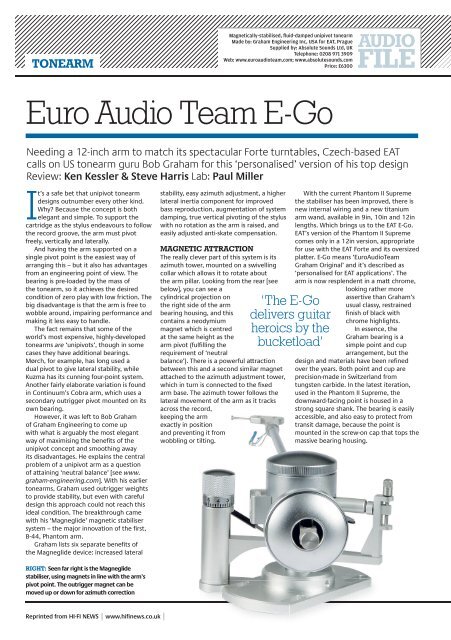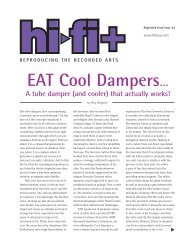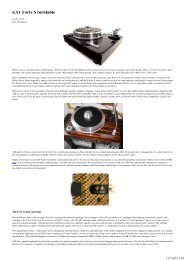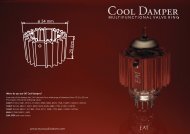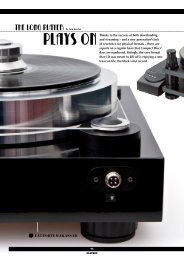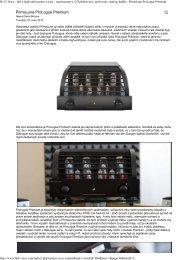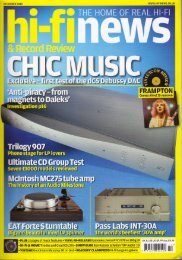EAT E-Go Tonearm - EuroAudioTeam.com
EAT E-Go Tonearm - EuroAudioTeam.com
EAT E-Go Tonearm - EuroAudioTeam.com
Create successful ePaper yourself
Turn your PDF publications into a flip-book with our unique Google optimized e-Paper software.
TONEARM<br />
Reprinted from HI-FI NEWS | www.hifinews.co.uk |<br />
<br />
<br />
<br />
<br />
<br />
<br />
Euro Audio Team E-<strong>Go</strong><br />
Needing a 12-inch arm to match its spectacular Forte turntables, Czech-based <strong>EAT</strong><br />
calls on US tonearm guru Bob Graham for this ‘personalised’ version of his top design<br />
Review: Ken Kessler & Steve Harris Lab: Paul Miller<br />
It’s a safe bet that unipivot tonearm<br />
designs outnumber every other kind.<br />
Why? Because the concept is both<br />
elegant and simple. To support the<br />
cartridge as the stylus endeavours to follow<br />
the record groove, the arm must pivot<br />
freely, vertically and laterally.<br />
And having the arm supported on a<br />
single pivot point is the easiest way of<br />
arranging this – but it also has advantages<br />
from an engineering point of view. The<br />
bearing is pre-loaded by the mass of<br />
the tonearm, so it achieves the desired<br />
condition of zero play with low friction. The<br />
big disadvantage is that the arm is free to<br />
wobble around, impairing performance and<br />
making it less easy to handle.<br />
The fact remains that some of the<br />
world’s most expensive, highly-developed<br />
tonearms are ‘unipivots’, though in some<br />
cases they have additional bearings.<br />
Mørch, for example, has long used a<br />
dual pivot to give lateral stability, while<br />
Kuzma has its cunning four-point system.<br />
Another fairly elaborate variation is found<br />
in Continuum’s Cobra arm, which uses a<br />
secondary outrigger pivot mounted on its<br />
own bearing.<br />
However, it was left to Bob Graham<br />
of Graham Engineering to <strong>com</strong>e up<br />
with what is arguably the most elegant<br />
way of maximising the benefits of the<br />
unipivot concept and smoothing away<br />
its disadvantages. He explains the central<br />
problem of a unipivot arm as a question<br />
of attaining ‘neutral balance’ [see www.<br />
graham-engineering.<strong>com</strong>]. With his earlier<br />
tonearms, Graham used outrigger weights<br />
to provide stability, but even with careful<br />
design this approach could not reach this<br />
ideal condition. The breakthrough came<br />
with his ‘Magneglide’ magnetic stabiliser<br />
system – the major innovation of the first,<br />
B-44, Phantom arm.<br />
Graham lists six separate benefits of<br />
the Magneglide device: increased lateral<br />
RIGHT: Seen far right is the Magneglide<br />
stabiliser, using magnets in line with the arm’s<br />
pivot point. The outrigger magnet can be<br />
moved up or down for azimuth correction<br />
stability, easy azimuth adjustment, a higher<br />
lateral inertia <strong>com</strong>ponent for improved<br />
bass reproduction, augmentation of system<br />
damping, true vertical pivoting of the stylus<br />
with no rotation as the arm is raised, and<br />
easily adjusted anti-skate <strong>com</strong>pensation.<br />
MAGNETIC ATTRACTION<br />
The really clever part of this system is its<br />
azimuth tower, mounted on a swivelling<br />
collar which allows it to rotate about<br />
the arm pillar. Looking from the rear [see<br />
below], you can see a<br />
cylindrical projection on<br />
the right side of the arm<br />
bearing housing, and this<br />
contains a neodymium<br />
magnet which is centred<br />
at the same height as the<br />
arm pivot (fulfilling the<br />
requirement of ‘neutral<br />
balance’). There is a powerful attraction<br />
between this and a second similar magnet<br />
attached to the azimuth adjustment tower,<br />
which in turn is connected to the fixed<br />
arm base. The azimuth tower follows the<br />
lateral movement of the arm as it tracks<br />
across the record,<br />
keeping the arm<br />
exactly in position<br />
and preventing it from<br />
wobbling or tilting.<br />
‘The E-<strong>Go</strong><br />
delivers guitar<br />
heroics by the<br />
bucketload’<br />
With the current Phantom II Supreme<br />
the stabiliser has been improved, there is<br />
new internal wiring and a new titanium<br />
arm wand, available in 9in, 10in and 12in<br />
lengths. Which brings us to the <strong>EAT</strong> E-<strong>Go</strong>.<br />
<strong>EAT</strong>’s version of the Phantom II Supreme<br />
<strong>com</strong>es only in a 12in version, appropriate<br />
for use with the <strong>EAT</strong> Forte and its oversized<br />
platter. E-<strong>Go</strong> means ‘<strong>EuroAudioTeam</strong><br />
Graham Original’ and it’s described as<br />
‘personalised for <strong>EAT</strong> applications’. The<br />
arm is now resplendent in a matt chrome,<br />
looking rather more<br />
assertive than Graham’s<br />
usual classy, restrained<br />
finish of black with<br />
chrome highlights.<br />
In essence, the<br />
Graham bearing is a<br />
simple point and cup<br />
arrangement, but the<br />
design and materials have been refined<br />
over the years. Both point and cup are<br />
precision-made in Switzerland from<br />
tungsten carbide. In the latest iteration,<br />
used in the Phantom II Supreme, the<br />
downward-facing point is housed in a<br />
strong square shank. The bearing is easily<br />
accessible, and also easy to protect from<br />
transit damage, because the point is<br />
mounted in the screw-on cap that tops the<br />
massive bearing housing.
RIGHT: The titanium arm wand is attached<br />
by a screw connector to the massive bearing<br />
housing, whose knurled top cap can be<br />
unscrewed to access the bearing cup and add<br />
the viscous damping fluid. Seen right is the VTA<br />
adjuster with its Vernier scale for fine tuning<br />
On first<br />
installation,<br />
having removed<br />
the blue plastic<br />
transit sleeve from<br />
the unipivot point,<br />
you fill the cup with an<br />
appropriate quantity of<br />
damping oil, then replace<br />
the cap. Alongside, the antiskate<br />
<strong>com</strong>pensation is not magnetic but<br />
achieved by a time-honoured thread-andweight<br />
system. But here, from a bell-crank<br />
that carries the adjustable weight, the<br />
thread runs round a small but exquisite<br />
pulley and is attached to the swivelling foot<br />
of the azimuth tower, avoiding the need<br />
for a direct connection to the arm.<br />
Azimuth adjustment is carried out<br />
by raising or lowering the magnet via a<br />
screwthread on its swivelling tower, this<br />
causing the arm to tilt as required. While<br />
you must not adjust azimuth during play,<br />
you can adjust the arm height and hence<br />
the vertical tracking angle – ‘VTA on the fly’<br />
has been a feature of Graham arms from<br />
the very start.<br />
Although the arm looks <strong>com</strong>plicated<br />
and even mysterious in its many<br />
GRAHAM ENGINEERING<br />
adjustments, it’s actually quite user friendly<br />
and <strong>com</strong>es with clear instructions. Our <strong>EAT</strong><br />
E-<strong>Go</strong> had the SME base, which of course<br />
made installation a painless procedure.<br />
As with previous models, it’s supplied<br />
with a neat device that registers the<br />
headshell with the turntable spindle to<br />
set the arm overhang correctly, and there<br />
is a special holder to provide accurate<br />
cartridge alignment.<br />
KEN SPINS SOME VINYL<br />
As the E-<strong>Go</strong> has a short back, it fitted<br />
the SME 30/12 without hitting the rear<br />
right pillar (as did my elderly SME 3012).<br />
Setup, despite the clever design, made me<br />
appreciate the genius of the SME Series<br />
V’s simplicity – but then the SME isn’t a<br />
unipivot. Thus, as far as ‘unis’ go, the E-<strong>Go</strong><br />
is one of the most user-friendly, as SH<br />
states. The removable wand makes it easy<br />
to change cartridges too: I settled on Air<br />
Tight’s PC1.<br />
Having just reviewed Gram Parsons’<br />
Grievous Angel as a MoFi SACD [HFN May<br />
’13], I dug out the vinyl [Reprise K54018]<br />
for more of the same. All was – how shall<br />
I put this? – wonderfully <strong>com</strong>prehensible<br />
until the end of ‘I Can’t Dance’.<br />
American engineer and designer Bob Graham can trace his passion for audio right<br />
back to the end of the mono era, when Weathers had its capacitance acitance cartridge<br />
mounted in a viscous-damped tonearm, tracking at a then-unprecedented unprecedented one<br />
gram. Graham recalls how salesmen would impress buyers by y casually tossing<br />
the arm on to the record, an act that would have caused<br />
serious damage with any other arm of the period. In<br />
the 1980s Graham took inspiration from SME’s superb<br />
engineering and finish and set out to build his own arms to similar imilar<br />
standards. While adopting the unipivot principle, he paid careful reful attention<br />
to the issues of resonance and dynamic stability, which he felt elt had been<br />
ignored by the designers of many other arms. The Graham 1.5 5 arm was<br />
launched in 1990, and this evolved into the 2.0 model and then en the 2.2. But<br />
in 2005 came the Phantom, a <strong>com</strong>pletely new design incorporating orating Graham’s<br />
patented Magneglide stabilisation system. Further enhancements ements brought the<br />
Phantom II and the current Phantom II Supreme, the basis of the <strong>EAT</strong> E-<strong>Go</strong>.<br />
We all have favourite tracks, parts of<br />
tracks even, we know so well that they<br />
serve as handy short-cuts for illustrating<br />
whether a system sounds convincingly<br />
realistic. They’ll be significant enough to<br />
convey a broad sensation, like voice, lead<br />
guitar, a strings section. As Parsons’ voice<br />
was so anodyne, that wasn’t gonna do it.<br />
What made me sit up and take notice was<br />
the drum-roll at the end of that track.<br />
It wasn’t mere impact: for that I’d<br />
turn to Kodo. It was about space and<br />
a lack of artifice. The sound of what is<br />
just a standard LP possessed the air and<br />
three-dimensionality of the crafted-to-amillimetre<br />
sound of the notorious Sheffield<br />
Drum Record. The crispness, the kick, lasts<br />
no more than a second, but the three that<br />
followed were to mere ‘air’ what Dyson is<br />
to dryers. I rubbed my eyes in disbelief.<br />
This confoundedness lasted only the<br />
length of the silence between tracks: it was<br />
followed by the delicate piano opening<br />
of ‘Brass Buttons’, <strong>com</strong>pounded by pedal<br />
steel and crisp, but discreet percussion.<br />
A snare, a cymbal, a woodblock, Parsons’<br />
vocals in the centre – the sound belied the<br />
title, for there was nothing brassy about it<br />
whatsoever. It managed, despite a surfeit<br />
of terse transients, to sound silky. And<br />
he hear hearing arin ing g it nnex<br />
next ext t to tthe<br />
the he admittedly aadm<br />
dmit itte tedl dly y cl clas classy assy sy<br />
SACD was an object lesson in why analogue<br />
remains more convincing than digital, for<br />
so many music music lovers.<br />
| www.hifinews.co.uk | Reprinted from HI-FI NEWS
TONEARM<br />
However dismissive I may be<br />
about Parsons’ pipes, the duet on<br />
‘Love Hurts’ with his muse, Emmylou<br />
Harris, is so achingly gorgeous that<br />
you begin to appreciate a system’s<br />
abilities with vocal textures and<br />
spacing. The two stand extreme left<br />
and right, the instruments filling in<br />
the space in-between, but this is<br />
not a stereo-circa-1956 ping-pong<br />
effect. It simply reflects the song’s<br />
title by using physical separation to<br />
convey the angst of love.<br />
Gram’s voice contrasts with<br />
Emmylou’s crystalline instrument,<br />
singing that is almost a country<br />
cliché. Again, the instruments<br />
exhibit speed and clarity, but never<br />
with any intrusiveness. The E-<strong>Go</strong><br />
perfectly resolved what is one of<br />
the most challenging of paradoxes:<br />
reproducing bags of information<br />
while creating what appears as a<br />
sparse soundscape. It’s precisely the<br />
kind of recording and playback that<br />
charms you back again and again,<br />
the deception of simplicity covering<br />
up genius-level <strong>com</strong>plexity.<br />
HOW CAN IT DO THIS?<br />
Probably the most tragicallyoverlooked,<br />
blues-based hard rock<br />
LP ever is Leslie West’s 1969 solo<br />
debut, Mountain [Windfall 4500]<br />
– the title of which would be<strong>com</strong>e<br />
the name of his band. As far as<br />
post-Cream power trios go, this was<br />
one of the best, West aided and<br />
abetted by Felix Pappalardi on bass<br />
and N D Smart II on drums, the latter<br />
so underappreciated that it simply<br />
makes me furious.<br />
‘Long Red’ is a curious number<br />
that has all the hallmarks of a heavy<br />
metal classic, yet the sound is light<br />
and subtle, almost unplugged. What<br />
throws you is West’s voice, a fiery<br />
rasp that contradicts and challenges<br />
the instrumentation – a circus-like<br />
organ and an acoustic guitar, for<br />
goodness’ sake!<br />
It’s the antithesis of Parsons’<br />
tentative, plaintive, I-wish-I-was-<br />
ABOVE: Plan view shows thread-andweight<br />
bias <strong>com</strong>pensator and neat<br />
clock-pendulum-shaped counterweight,<br />
designed for good operating clearances<br />
George-Jones whisper. Having met<br />
West, and seen Mountain live, I<br />
can think of no other New York<br />
Yiddishe bocher who can sound as<br />
convincingly like a 1950s R&B wailer.<br />
West, of course, is famed more<br />
for his powerful fluid guitar work<br />
than his singing, and the E-<strong>Go</strong><br />
delivers guitar heroics by the<br />
bucketload. Once you get past the<br />
disparity between the vocal style<br />
and the song it’s conveying (the<br />
same effect as when Joe Cocker<br />
sings a ballad) you can lean back and<br />
marvel at the way it all coalesces.<br />
It is a demonstration of balancing<br />
textures that should, by any<br />
definition, <strong>com</strong>pete with each other<br />
to the point of self-defeat. Instead,<br />
it’s sound is so ‘of a whole’ that you<br />
wonder how just an arm can do this.<br />
Not that I would ditch the SME<br />
Series V 12in. It offers superior<br />
lower bass solidity, more tactile than<br />
the E-<strong>Go</strong>’s deepest registers, but<br />
it’s down to taste and partnering<br />
equipment. If you can handle a 12in<br />
arm, the E-<strong>Go</strong> joins a select group of<br />
top contenders.<br />
HI-FI NEWS VERDICT<br />
As the E-<strong>Go</strong> was preceded by the<br />
Graham tonearms’ substantive<br />
reputation, and I’d heard Bob’s<br />
tonearms so many times that I<br />
knew to expect with certainty<br />
both refinement and finesse, <strong>EAT</strong>’s<br />
version merely confirmed my<br />
experience. This is an estimable<br />
arm, as genuinely a ‘high-end’<br />
purchase as one could make,<br />
bristling with clever details and<br />
sounding gorgeous. Best of all, it’s<br />
a unipivot free of masochism.<br />
Sound Quality: 85%<br />
0 - - - - - - - - 100<br />
LAB<br />
REPORT<br />
EURO AUDIO TEAM E-GO<br />
The addition of Graham’s ‘Magneglide’ stabilisation regime<br />
to its Phantom platform makes this the most stable unipivot<br />
design that we’ve tested, damping any rotational displacement<br />
without adding obvious friction to either vertical or horizontal<br />
movement. Because the unipivot ‘bearing’ is positioned within<br />
a well of oil, measureable friction – fluid viscosity – rather<br />
depends on the frequency of movement, but with the slow arm<br />
movements encountered during replay this amounts to


